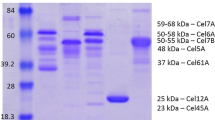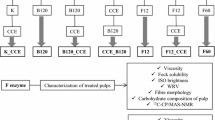Abstract
Hardwood dissolving pulp was treated with purified Trichoderma reesei endoglucanases and cellobiohydrolases. Endoglucanases were more efficient in hydrolysing pulp carbohydrates than were the cellobiohydrolases at the same protein dosage. Endoglucanases also lowered the viscosity and improved the alkaline solubility more dramatically. There was a clear correlation between the alkaline solubility and viscosity, and therefore the solubility could only be improved by lowering the viscosity of the pulp. At the same degree of cellulose degradation, endoglucanase II was found to be most effective in reducing the viscosity and thus improving the solubility. Cellobiohydrolases had a less pronounced effect on the viscosity or solubility.
Similar content being viewed by others
References
Bailey, M. J., Siika-aho, M., Valkeajärvi, A. and Penttilä, M. E. (1993) Hydrolytic properties of two cellulases ofTrichoderma reesei expressed in yeast.Biotechnol. Appl. Biochem. 17, 65–76.
Buchert, J., Siika-aho, M. and Bailey, M. (1993) Quantitative determination of wood-derived soluble oligosaccharides by HPLC.Biotechnol. Techniques 7, 785.
Chanzy, H. and Henrissat, B. (1985) Undirectional degradation ofValonia cellulose microcrystals subjected to cellulase action.FEBS Lett. 184, 285–288.
Chanzy, H. and Paillet, M. (1990) Spinning of cellulose from N-methyl morpholine N-oxide in the presence of additives.Polymer 32, 400.
Kleman-Leyer, K. M., Siika-aho, M., Teeri, T. T. and Kirk, T. K. (1995) EGI and CBHII ofTrichoderma reesei act synergistically to solubilize native and cotton cellulose, but not to decrease its molecular size. unpublished work.
Ladish, M. R., Lin, K. W., Voloch, M. and Tsao, G. T. (1983) Process considerations in the enzymatic hydrolysis of biomass.Enzyme Microb. Technol. 5, 82–102.
Laivins, G. V. and Scallan, A. M. (1993) The mechanism of hornification of wood pulps. Products of papermaking.Trans. 10th Fundamental Research Symposium. Oxford, September 1993, Vol. 2, pp. 1235–1257.
Lowry, O. H., Rosebrough, N. H., Farr, A. R. and Randall, R. J. (1951) Protein measurement with the Folin phenol reagent.J. Biol. Chem. 193, 265–275.
Nevalainen, H. and Penttilä, M. (1995) Molecular biology of cellulolytic fungi.The Mycota II: Genetics and Biotechnology (Kück, ed.), Berlin/Heidelberg: Springer-Verlag, 304–319.
Parekh, I. H., Moulik, S. K. R. and Sodani, S. K. (1977) Dissolving Grade Pulps from Eucalyptus (tereticornis) Hybrid,Proceedings of the TAPPI 4th International Dissolving Pulps Conference, Sept. 28–30, Chicago, pp. 88–100.
Pere, J., Siika-aho, M., Buchert, J. and Viikari, L. (1995) Effects of purifiedTrichoderma reesei cellulases on the fiber properties of kraft pulp,Tappi J. 78, 71–78.
Struszczyk, H. (1988) Alternative technologies of cellulose fibres manufacture I. Carbamate cellulose production.Wló kna Chemiczne 14, 365–379.
Struszczyk, H. (1989a) Alternative technologies of cellulose fibres manufacture II. Cellulose fibres manufacture from cellulose carbamate.Wlókna Chemiczne 15, 7–22.
Struszczyk, H. (1989b) Alternative technologies of cellulose fibres manufacture III. Properties of fibres from cellulose carbamate.Wlókna Chemiczne 15, 169–179.
Suominen, P., Mäntylä, A., Karhunen, T., Hakola, S. and Nevalainen, H. (1993) High frequency onestep replacement inTrichoderma reesei II. Effects of deletions of individual genes.Mol. Gen. Genet. 241, 523–530.
Treiber, E. E. (1987) Formation of fibers from cellulose solutions. InCellulose chemistry and its applications (T. P. Nevell and H. Zeronian, eds.), Chichester: Ellis Horwood, 455–479.
van Tilbeurgh, H., Bhikhabhai, R., Pettersson, L. and Claeyssens, M. (1984) Separation of endo- and exo-type cellulases using a new affinity chromatography method.FEBS Lett. 169, 215–218.
Vehviläinen, M., Nousiainen, P., Strusczyk, H. and East, G. (1994) Celsol — Biotransformation of cellulose for fibre spinning.Proc. Cellucon International Cellulose Conference, September 19–23, Wales, Ellis Horwood Series in Polymer Science and Technology (J. F. Kennedy, ed.), in press.
Wood, T. M. and Garcia-Campayo, V. (1990) Enzymology of cellulose degradation.Biodegradation 1, 147–161.
Zurbriggen, B. Z., Bailey, M. J., Penttilä, M. E., Poutanen, K. and Linko, M. (1990) Pilot scale production of a heterologousTrichoderma reesei cellulase inSaccharomyces cerevisiae.J. Biotechnol. 13, 267–278.
Zurbriggen, B. D., Penttilä, M. E., Viikari, L. and Bailey, M. J. (1991) Pilot scale production of aTrichoderma reesei endo-β-glucanase by brewer's yeast.J. Biotechnol. 17, 133–146.
Author information
Authors and Affiliations
Rights and permissions
About this article
Cite this article
Rahkamo, L., Siika-Aho, M., Vehviläinen, M. et al. Modification of hardwood dissolving pulp with purifiedTrichoderma reesei cellulases. Cellulose 3, 153–163 (1996). https://doi.org/10.1007/BF02228798
Issue Date:
DOI: https://doi.org/10.1007/BF02228798




